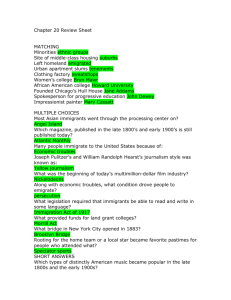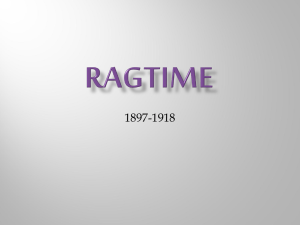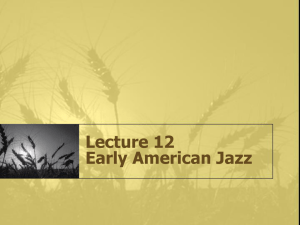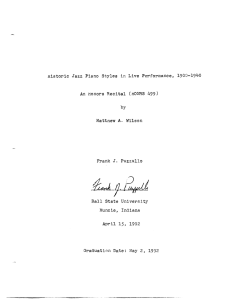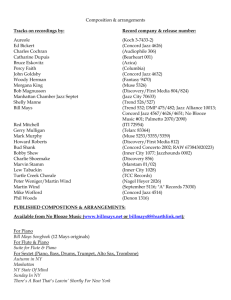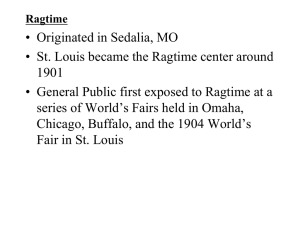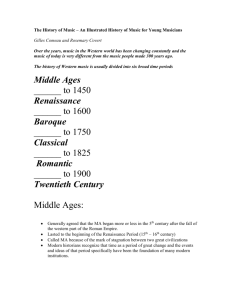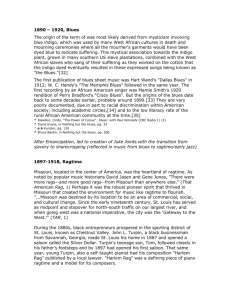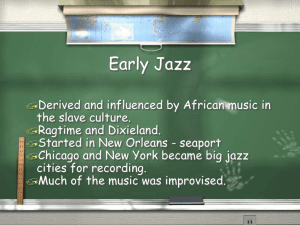MUS 102 Study Guide for Final Exam
advertisement
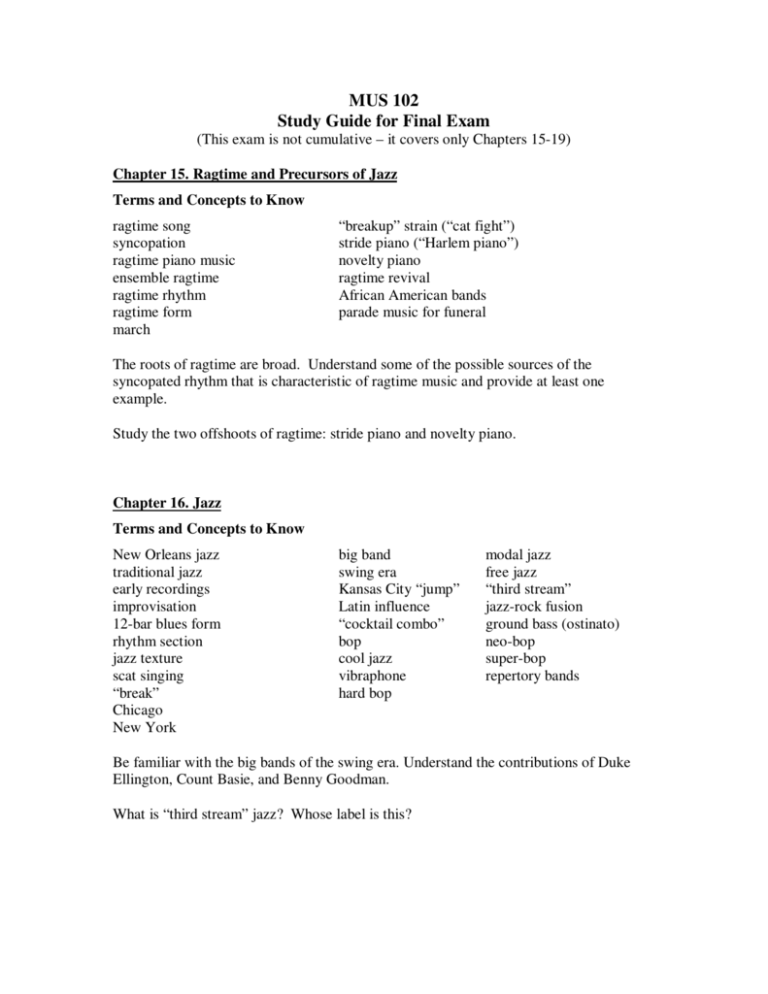
MUS 102 Study Guide for Final Exam (This exam is not cumulative – it covers only Chapters 15-19) Chapter 15. Ragtime and Precursors of Jazz Terms and Concepts to Know ragtime song syncopation ragtime piano music ensemble ragtime ragtime rhythm ragtime form march “breakup” strain (“cat fight”) stride piano (“Harlem piano”) novelty piano ragtime revival African American bands parade music for funeral The roots of ragtime are broad. Understand some of the possible sources of the syncopated rhythm that is characteristic of ragtime music and provide at least one example. Study the two offshoots of ragtime: stride piano and novelty piano. Chapter 16. Jazz Terms and Concepts to Know New Orleans jazz traditional jazz early recordings improvisation 12-bar blues form rhythm section jazz texture scat singing “break” Chicago New York big band swing era Kansas City “jump” Latin influence “cocktail combo” bop cool jazz vibraphone hard bop modal jazz free jazz “third stream” jazz-rock fusion ground bass (ostinato) neo-bop super-bop repertory bands Be familiar with the big bands of the swing era. Understand the contributions of Duke Ellington, Count Basie, and Benny Goodman. What is “third stream” jazz? Whose label is this? Chapter 17. The Search for an American Identity Terms and Concepts to Know cultivated vernacular debate over nationality “nativist” view American symphony orchestra Second New England School suite for orchestra Wa-Wan Press virtuosity cult To what extent is there a distinctly American contribution to classical music? Who was classically trained prior to dropping out of high school to become a song “plugger” on Tin Pan Alley? Understand America’s virtuoso cult, especially the musical life of Louis Moreau Gottschalk. Outline the mid-nineteenth-century debate over nationality between the “nativist” view and its critics. Chapter 18. Twentieth-Century Innovation and the Contemporary World Terms and Concepts to Know program music collage of sound simultaneity modernism New York City The “Machine Age” mid-century modernism serialism chance (or aleatoric) music tone clusters electronic music sampling minimalism phase shifting Continental Harmony Project Prior to John Cage, which composer wrote pieces calling for the performer to play directly on the strings of the piano? Which type of music did NOT maximize rational control by the composer? Define minimalism and cite an example that we discussed in class. Discuss the contributions of John Cage and some of the questions that he attempted to assert with his composition 4’33’’. Chapter 19. Film Music Terms and Concepts to Know symphonic film score cue glissando Richard Wagner’s influence on film scores classical style film music pop, folk, and rock soundtracks Compare and contrast the musical style in the film music of Max Steiner, Bernard Hermann, and John Williams. Part V Jazz and its Forerunners Maple Leaf Rag Scott Joplin If Dreams Come James P. Johnson True Just a Little While Eureka Brass Band to Stay Here Hotter Than That Louis Armstrong and His Hot Five Ko-Ko Duke Ellington and His Orchestra KoKo Charlie Parker Out of This World John Coltrane Bitches Brew Miles Davis Part VI Classical Music Pawnee Horses Arthur Farwell Rhapsody in Blue George Gershwin Afro-American William Grant Still Symphony Appalachian Spring Aaron Copland The Banjo Louis Gottschalk Four New England Charles Ives Holidays The Banshee Henry Cowell Piano Phase Steve Reich The Bushy Wushy Philip Bimstein Rag “The Imperial John Williams March” from Star Wars CD 3, Track 17 CD 3, Track 18 p. 252 p. 254 CD 3, Track 20 p. 259 CD 3, Track 22 p. 265 CD 3, Track 23 p. 268 CD 3, Track 24 CD 3, Track 25 CD 4, Track 1 p. 272 p. 274 p. 276 CD 4, Track 2 CD 4, Track 3 CD 4, Track 4 p. 290 p. 291 p. 293 CD 4, Track 5 CD 4, Track 6 CD 4, Track 8 p. 294 p. 295 p. 302 CD 4, Track 10 CD 4, Track 11 CD 4, Track 12 p. 306 p. 310 p. 312 CD 4, Track 14 p. 319
